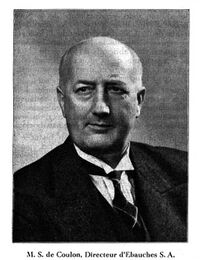Sydney de Coulon: Difference between revisions
No edit summary |
|||
| Line 1: | Line 1: | ||
[[File:FH 1940 1205 05 Sydney de Coulon portrait.jpg|right|200px]] | |||
Sydney de Coulon ([[1889]]-[[1976]]) was called the "Grand Patron" of Swiss watchmaking. He ran [[Ebauches SA]] from [[1933]] through [[1964]], giving him indirect control over most Swiss watch manufacturers through [[ASUAG]] and the [[cartel]]. | Sydney de Coulon ([[1889]]-[[1976]]) was called the "Grand Patron" of Swiss watchmaking. He ran [[Ebauches SA]] from [[1933]] through [[1964]], giving him indirect control over most Swiss watch manufacturers through [[ASUAG]] and the [[cartel]]. | ||
Revision as of 18:34, 21 October 2023

Sydney de Coulon (1889-1976) was called the "Grand Patron" of Swiss watchmaking. He ran Ebauches SA from 1933 through 1964, giving him indirect control over most Swiss watch manufacturers through ASUAG and the cartel.
Early Life
Sydney de Coulon was born on March 24, 1889 and raised on the family estate known as Treytel along the shore of Lac de Neuchâtel near Bevaix. His father Alfred de Coulon and mother Léonie had 13 children (three of whom did not survive) and Sydney was the youngest. His father was a banker in England, and young Sydney did a 24 month internship there where he learned about the stock market. He was later known to smoke a pipe, a habit he claims to have picked up in England at this time.
FHF
Returning to Switzerland, de Coulon helped establish a new bank in Lausanne. Although not a watch industry insider but was asked to help manage the Fabrique d'Horlogerie de Fontainemelon in 1918. Taking an interest in watchmaking, de Coulon took on a technical apprenticeship to learn more about the construction of watch movements. He joined FHF management in May 1925.
Serving under Paul Robert at FHF, de Coulon saw that consolidation of the industry was necessary and was part of the acquisition of Charles Hahn in Le Landeron by FHF in 1927.
It was from Fontainemelon that he would join the consolidation of the watch industry in the 1920s and 1930s: On December 27, 1926, FHF was a founding member of Ebauches SA. de Coulon was brought in as outside secretary for Ebauches SA, likely at the suggestion of his boss Paul Robert, and soon rose to lead the cartel. But first he would lead the "Superholding" known as ASUAG as secretary from 1931, and this activity pulled him away from FHF, resigning management there in 1932.
ASUAG
When Ebauches SA banded together with watchmakers, FSR, and the Swiss banks to form ASUAG in 1931, Sydney de Coulon was selected as the first secretary on August 14, 1931. This gave him the opportunity to leverage his banking and watchmaking connections and to prove his value as an administrator and industry leader. His leadership was championed by Hermann Obrecht, called the father of Ebauches SA due to his involvement in government and the watch industry. Obrecht took a chance on the young man, whom he saw as a protege.
de Coulon quickly became involved in ASUAG and Ebauches SA members, joining the boards of Eterna and ETA in March 1932. And he joined the board of Ebauches SA itself in July of 1932. He was also responsible for liquidating Wasa that year.
Ebauches SA
Sydney de Coulon lead Ebauches SA starting in 1933 and became one of the strongest forces in Swiss industry. Although part of ASUAG, Ebauches SA was at the center of the fight over dissidence, quotas, and export controls. de Coulon also pushed for the establishment of a Swiss research laboratory, which would give rise to the quartz watch among other innovations, as well as a pension fund for watchmakers.
In 1937 he was named sole director of the ebauche factory in Chézard (formerly Mader & Co) and joined the board of Unitas and ARSA. 1938 saw him as a founding board member of Glucydur and overseeing the acquisition of Société Suisse des Spiraux. In 1939, Sydney de Coulon was made vice president of Ebauches Bettlach and a founding board member of the Laboratoire de Recherches Horlogères. He re-joined the board of FHF, representing ASUAG, in 1940.
In 1941 de Coulon became more involved in the other branches of watch manufacturing, joining the boards of Fabriques de Balanciers Réunies and Fabriques d'Assortiments Réunies. He became president of Groupement Roskopf, though resigning in 1944, as well as the Fondation Charles-Edouard Guillaume.
He also oversaw the acquisition of new companies by Ebauches SA, including Derby and Nouvelle Fabrique Tavannes in 1941, and Valjoux in 1944. He personally took charge of Vénus in 1947, which he had joined in 1928 as it was integrated into Ebauches SA.
One of his final acts as chairman of Ebauches SA was the establishment in 1962 of the Centre Electronique Horloger. Serving as secretary, he directed the funding of the CEH as it investigated electric, electronic, and quartz watches.
In 1964, de Coulon pulled back from the watchmaking industry, giving up his position at Ebauches SA and most affiliated companies over the next few years. One of the final roles he relinquished was service on the board of FHF, where he began his career.
Later Life
de Coulon was also a member of Swiss parliament from 1941 through 1954, a national councillor from 1947 through 1949, and served in the cantonal government for 14 years. He chaired the Liberal Democratic Association nationally. He was also the captain of the Fontainemelon firefighting corps and served on the local council.
In April 1964, Sydney de Coulon resigned as CEO of Ebauches SA. Although he and his wife intended to travel and enjoy life, she died three years later. Sydney de Coulon died on August 17, 1976 and was remembered as "the grandfather of Swiss watchmaking."